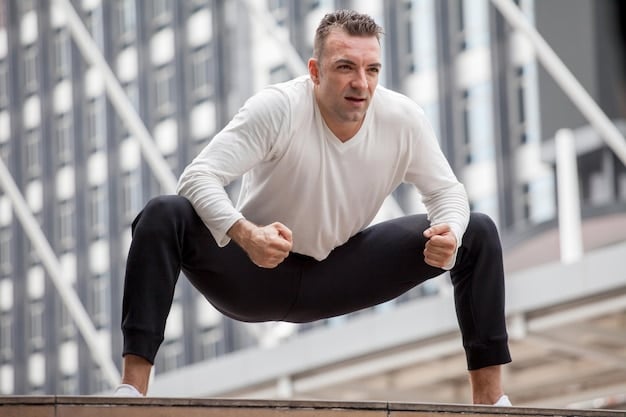Sculpt Your Core: 15-Minute Ab Routine for Visible Results

Achieving a strong, defined core is attainable through a strategic 15-minute ab routine, designed to yield visible results within 30 days by integrating consistent, targeted exercises that engage all major abdominal muscle groups effectively.
Embarking on a fitness journey often centers around specific, achievable goals. For many, a strong, sculpted core is high on that list, promising not only aesthetic appeal but also significant benefits for overall health and athletic performance. This article delves into how you can Sculpt Your Core: The 15-Minute Ab Routine for Visible Results in 30 Days, transforming your midsection with a focused and efficient approach.
The Science Behind Core Strength and Definition
Understanding the anatomy and physiology of your core muscles is the first step towards effectively training them for strength and definition. The core is far more than just your “abs”; it’s a complex network of muscles that stabilize your spine, pelvis, and torso, playing a critical role in almost every movement you make.
Deep core muscles, such as the transverse abdominis, act like a natural corset, providing internal support. Superficial muscles, like the rectus abdominis (the “six-pack” muscle) and obliques, contribute to visible definition and rotational movements. Engaging these muscles synergistically is key to not only a sculpted appearance but also improved posture, reduced back pain, and enhanced athletic performance.
Beyond the Six-Pack: Comprehensive Core Engagement
While the rectus abdominis often gets all the attention, a truly strong and defined core relies on balanced development of all its components. Focusing solely on crunches might give you some superficial development, but it won’t build the functional strength necessary for a resilient and active body. Our routine emphasizes exercises that target the full spectrum of core musculature.
- Rectus Abdominis: Responsible for spinal flexion (like crunches).
- Obliques (Internal and External): Key for twisting and side-bending movements.
- Transverse Abdominis: The deepest abdominal muscle, essential for core stability and intra-abdominal pressure.
- Erector Spinae & Multifidus: Back muscles that support the spine, often overlooked in core training.
Building core strength is also about consistency. Just as you wouldn’t expect to run a marathon after one week of training, visible abdominal results require dedication over time. The 30-day timeline isn’t about magical transformation, but about establishing a routine that builds progressive strength and allows for noticeable changes in muscle tone and definition, especially when combined with a balanced diet.
Designing Your 15-Minute Daily Core Routine
Efficiency is paramount when time is limited. A 15-minute core routine needs to be packed with effective exercises that maximize muscle engagement and minimize wasted time. The key is compound movements and strategic sequencing to hit all major core areas without excessive rest periods.
Exercise Selection: Quality Over Quantity
Choosing the right exercises makes all the difference. Instead of performing dozens of ineffective repetitions, we focus on movements that deeply engage the core. This routine prioritizes exercises that allow for full range of motion and effective muscle contraction.
- Plank Variations: Fundamental for stability, engaging the entire core.
- Leg Raises: Target the lower abdominals, often a challenging area.
- Russian Twists: Excellent for developing the obliques and rotational strength.
- Bicycle Crunches: Combine upper and lower body movement for comprehensive engagement.
The beauty of this 15-minute routine lies in its adaptability. You can perform these exercises virtually anywhere, with minimal or no equipment. Your own body weight provides sufficient resistance to challenge your muscles and stimulate growth. Remember to focus on controlled movements and proper form over speed, as proper execution vastly amplifies the effectiveness of each exercise.
The 30-Day Blueprint: Consistency and Progression
Consistency is the bedrock of any successful fitness regimen. Committing to a daily 15-minute core routine for 30 days is a manageable goal that can yield impressive results. This blueprint focuses on progressive overload, meaning you gradually increase the intensity or volume of your workouts as your strength improves.

Week 1-2: Master the Fundamentals
The initial two weeks are dedicated to mastering proper form and building a foundational level of strength. Focus on executing each movement with precision, feeling the target muscles engage. Don’t rush through the exercises; control is more important than speed at this stage.
Start with a manageable number of repetitions or hold times, and gradually increase them as you become stronger. For instance, if you can only hold a plank for 30 seconds initially, aim for 35 or 40 seconds by the end of the first week. Similarly, if you manage 10 leg raises, try for 12 or 15 in subsequent sessions. Pay close attention to your body’s signals and ensure you’re not overexerting yourself, especially on days you might feel fatigued.
Week 3-4: Increase Intensity and Variations
Once you’ve built a solid foundation, weeks three and four introduce variations and increased intensity. This could involve performing more challenging versions of exercises, increasing the number of reps or sets, or reducing rest times between exercises. This progressive overload prevents your muscles from adapting too quickly and ensures continuous development.
For example, transition from basic planks to side planks or plank variations with leg lifts. If regular crunches feel too easy, try reverse crunches or add a slow, controlled movement to increase time under tension. This phase is crucial for pushing past plateaus and truly challenging your core. Remember, the goal is not just to do the exercises, but to do them with purpose and intent, feeling the muscles work through every repetition.
By adhering to this structure, you create a dynamic and engaging routine that evolves with your strength. The 30-day mark serves as a significant milestone, allowing you to observe clear improvements in both strength and visible definition, motivating you to continue your fitness journey.
The 15-Minute Ab Routine Breakdown
Here’s a detailed breakdown of the 15-minute routine, designed for maximum efficiency and comprehensive core engagement. Perform each exercise with focus on form, taking minimal rest between sets to keep your heart rate up and muscle engagement high.
Warm-Up (2 minutes)
Always begin with a brief warm-up to prepare your muscles. Light cardio like marching in place, arm circles, and gentle torso twists will increase blood flow and reduce the risk of injury. Dynamic stretches are more beneficial here than static holds.
- Marching in Place: 30 seconds
- Arm Circles (forward and backward): 30 seconds
- Torso Twists (gentle): 30 seconds
- Cat-Cow Stretch: 30 seconds
A proper warm-up ensures your muscles are pliable and ready for the forthcoming exertion. It also mentally prepares you for the workout ahead, helping you to connect with your body and focus on the movements.
The Core Workout (12 minutes)
Perform each exercise for the specified duration or repetitions, moving directly to the next with minimal rest. Aim for 30-45 seconds of work per exercise, followed by a 15-second transition. Complete two full rounds of the circuit.
1. Plank (60 seconds): Hold a straight line from head to heels, engaging your glutes and abs. Keep your elbows directly under your shoulders. This foundational exercise anchors off all your major abdominal muscles, fostering stability.
2. Crunches (30-45 seconds): Lie on your back, knees bent, feet flat. Place hands behind your head or across your chest. Lift your shoulders off the floor, engaging your upper abs. Focus on controlled movement, not momentum.
3. Bicycle Crunches (30-45 seconds): Lie on your back, knees bent, hands behind head. Bring opposite elbow to opposite knee, extending the other leg. Alternate sides in a fluid motion. This exercise targets both the rectus abdominis and the obliques, requiring coordinated movement.
4. Leg Raises (30-45 seconds): Lie on your back, legs straight. Slowly lift your legs towards the ceiling, keeping them as straight as possible, until your hips slightly lift off the floor. Lower slowly. This challenges the lower abdominal muscles extensively.
5. Russian Twists (30-45 seconds): Sit on the floor, knees bent, feet flat or slightly elevated. Lean back slightly, engaging your core. Twist your torso from side to side, touching the floor beside you with your hands or a light weight. This motion effectively sculpts the obliques.
6. Plank Jacks (30-45 seconds): Start in a high plank position. Jump your feet out wide, then jump them back together, similar to a jumping jack, while maintaining a stable upper body. This adds a cardiovascular element while challenging core stability.
7. Side Plank (30 seconds each side): Prop yourself up on one forearm, stacking your feet. Keep your body in a straight line, engaging your obliques. This is paramount for lateral core strength and definition.
Cool-Down (1 minute)
Finish with gentle stretches to improve flexibility and aid recovery. Hold each stretch for 20-30 seconds.
- Cobra Stretch: Lie on your stomach, hands under shoulders, gently push up to arch your back.
- Child’s Pose: Sit back on your heels, torso forward, arms extended.
This structure guarantees efficient and effective training. Remember, the true magic lies in the consistent application of these principles, adapting the routine as your strength grows. By remaining disciplined with this structure, you’ll be on your way to visible core definition within 30 days.
Nutritional Support: Fueling Your Core Transformation
While exercise is crucial for muscle development, nutrition plays an equally vital role in revealing those hard-earned abs. A well-sculpted core can remain hidden under a layer of body fat, regardless of how strong your muscles become. Therefore, optimizing your diet is non-negotiable for visible results.
Strategic Calorie Management
To reduce body fat, you generally need to be in a modest calorie deficit – consuming slightly fewer calories than you burn. This doesn’t mean drastic deprivation, which can be counterproductive, but rather sensible portion control and smart food choices. Aim for gradual, sustainable fat loss, typically 1-2 pounds per week, to preserve muscle mass.
Focus on nutrient-dense foods that provide satiety. Lean proteins, complex carbohydrates, healthy fats, and a plethora of fruits and vegetables should form the cornerstone of your diet. Avoiding excessive processed foods, sugary drinks, and unhealthy saturated or trans fats will significantly aid your progress. Hydration is also paramount; drinking plenty of water supports metabolism and can help manage hunger.
Understanding your daily caloric needs and tracking your intake, at least temporarily, can provide valuable insight into where adjustments can be made. This awareness can prevent accidental overeating and ensure you’re consistently working towards a favorable body composition.
Macronutrient Balance for Optimal Results
The right balance of macronutrients (proteins, carbohydrates, and fats) is essential for muscle recovery, energy, and fat loss. Each plays a distinct role in your body’s performance and composition:
- Protein: Crucial for muscle repair and growth, and promotes satiety. Aim for lean sources such as chicken breast, fish, eggs, tofu, and legumes.
- Complex Carbohydrates: Provide sustained energy for your workouts and daily activities. Opt for whole grains, oats, quinoa, brown rice, and nutrient-rich vegetables.
- Healthy Fats: Important for hormone production and nutrient absorption. Include sources like avocados, nuts, seeds, and olive oil in moderation.
Meal timing can also be a factor, though individual preferences vary. Consuming a good balance of protein and complex carbs before and after workouts can aid in recovery and energy levels. Ultimately, consistency in nutritional choices, combined with your 15-minute core routine, is the most powerful catalyst for achieving visible abdominal definition within the 30-day window and maintaining it long-term.

Addressing Common Challenges and Maximizing Success
The path to a sculpted core isn’t always linear. There will be days when motivation wanes or progress seems slow. Understanding common challenges and having strategies to overcome them is crucial for long-term success, especially within an ambitious 30-day timeframe.
Overcoming Plateaus and Maintaining Motivation
Plateaus are a natural part of any fitness journey. When your body adapts to a routine, progress can slow or even halt. This is why progressive overload, as discussed earlier, is so important. If you feel stuck, consider increasing the duration of holds, adding more reps, or performing more challenging variations of your current exercises. For example, if regular planks are easy, try a plank with an arm or leg lift.
Motivation can fluctuate. To stay on track, set realistic mini-goals throughout the 30 days. Perhaps aiming to add one extra rep to each exercise every few days, or simply completing the full 15 minutes without stopping. Tracking your progress, whether in a journal or a fitness app, can provide clear evidence of your improvement, which is a powerful motivator. Celebrate small victories and remind yourself of your ultimate goal. Find an accountability partner if possible, as sharing your journey can provide crucial support and encouragement.
Listen to Your Body and Prevent Injury
While consistency is key, pushing your body too hard can lead to injury, which completely derails progress. Pay close attention to your body’s signals. If you feel sharp pain during an exercise, stop immediately. Distinguish between muscle fatigue, which is normal and desirable, and actual pain. Proper form should always take precedence over speed or the number of repetitions. If your form is compromised, reduce the intensity or number of reps until you can perform the exercise correctly.
Adequate rest and recovery are just as important as the workout itself. Your muscles grow and repair during rest, not during exercise. Ensure you’re getting sufficient sleep (7-9 hours per night) and consider incorporating active recovery, such as light walking or gentle stretching, on your non-workout days. Proper hydration and nutrition also significantly contribute to faster recovery and reduced muscle soreness. By prioritizing these elements, you not only maximize your chances of achieving a sculpted core but also ensure a sustainable and injury-free fitness journey.
Ultimately, the journey to a sculpted core within 30 days is a testament to consistency, intelligent training, and a holistic approach to wellness. It’s about building sustainable habits that extend far beyond the initial timeframe, creating a stronger, more resilient you.
| Key Aspect | Brief Description |
|---|---|
| ⏱️ 15-Minute Routine | Efficient daily core workout, maximizing muscle engagement. |
| 🗓️ 30-Day Goal | Achieve visible results through consistency and progressive overload. |
| 💪 Core & Nutrition | Importance of both targeted exercise and strategic diet for definition. |
| 🧘♀️ Mindful Training | Focus on proper form, injury prevention, and listening to your body. |
Frequently Asked Questions About Core Training
▼
Visible results typically begin appearing within 30 days of consistent application. However, individual progress varies based on factors like genetics, starting fitness level, and adherence to dietary recommendations. Some may notice improvements in strength and endurance sooner, with aesthetic changes following as body fat decreases and muscle tone increases.
▼
No special equipment is required for this 15-minute ab routine. All exercises can be performed using only your body weight, making it incredibly accessible for home workouts or while traveling. A yoga mat can be beneficial for comfort but is not strictly necessary for executing the exercises effectively.
▼
While the routine is designed to be daily, listening to your body is crucial. For beginners, 4-5 times a week might be more appropriate, allowing muscles to recover. As your strength increases, daily execution is feasible, as core muscles often recover faster than larger muscle groups. Pay attention to signs of overtraining, like persistent soreness.
▼
Absolutely. Nutrition is just as vital as exercise, if not more, for achieving visible abs. Even with strong core muscles, a layer of body fat can obscure definition. A balanced diet, focusing on lean protein, complex carbs, and healthy fats, along with a modest calorie deficit, is essential for reducing body fat and revealing your abdominal muscles.
▼
It’s perfectly fine if you can’t complete all exercises or reps initially. The key is consistency and progressive improvement. Start with what you can comfortably manage while maintaining proper form, whether it’s fewer reps or shorter hold times. Gradually increase as your strength improves. Consistency over perfection is the priority.
Conclusion
Achieving a sculpted core within 30 days is an ambitious yet entirely attainable goal through dedicated adherence to this 15-minute daily ab routine, coupled with mindful nutrition. By understanding the science behind core strength, meticulously designing your workout, and committing to consistency and progressive overload, you embark on a transformative journey. Remember, visible results are not merely about aesthetics; they signify enhanced stability, improved posture, and a stronger foundation for overall physical well-being. Embrace the challenge, listen to your body, and celebrate each small victory on your path to a more defined and functional core.





